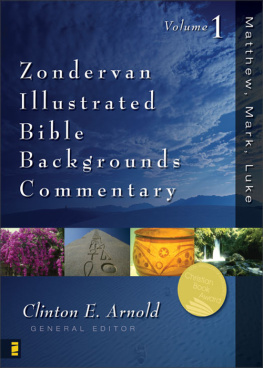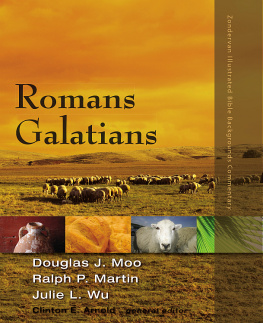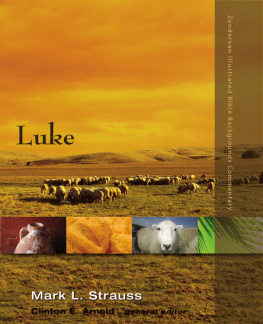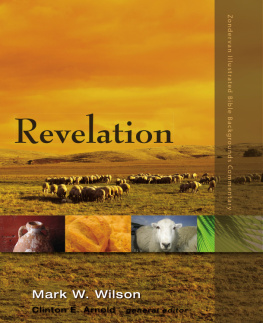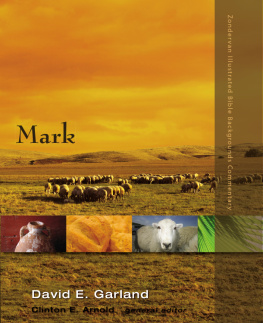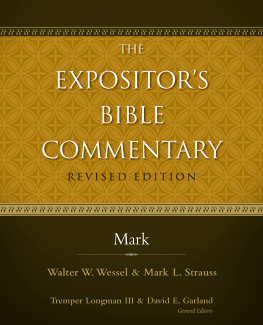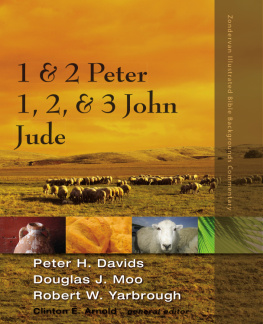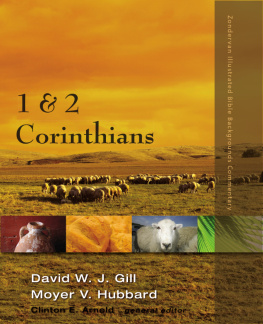Zondervan Illustrated Bible Backgrounds Commentary
Matthew
Michael J. Wilkins
Mark
Mark L. Strauss
Luke
David E. Garland

CONTENTS
Zondervan Illustrated Bible Backgrounds Commentary
Matthew
Michael J. Wilkins
Clinton E. Arnold general editor

CONTENTS
All readers of the Bible have a tendency to view what it says it through their own culture and life circumstances. This can happen almost subconsiously as we read the pages of the text.
When most people in the church read about the thief on the cross, for instance, they immediately think of a burglar that held up a store or broke into a home. They may be rather shocked to find out that the guy was actually a Jewish revolutionary figure who was part of a growing movement in Palestine eager to throw off Roman rule.
It also comes as something of a surprise to contemporary Christians that cursing in the New Testament era had little or nothing to do with cussing somebody out. It had far more to do with the invocation of spirits to cause someone harm.
No doubt there is a need in the church for learning more about the world of the New Testament to avoid erroneous interpretations of the text of Scripture. But relevant historical and cultural insights also provide an added dimension of perspective to the words of the Bible. This kind of information often functions in the same way as watching a movie in color rather than in black and white. Finding out, for instance, how Paul compared Christs victory on the cross to a joyous celebration parade in honor of a Roman general after winning an extraordinary battle brings does indeed magnify the profundity and implications of Jesus work on the cross. Discovering that the factions at Corinth (I follow Paul I follow Apollos) had plenty of precedent in the local cults (I follow Aphrodite; I follow Apollo) helps us understand the why of a particular problem. Learning about the water supply from the springs of Hierapolis that flowed into Laodicea as lukewarm water enables us to appreciate the relevance of the metaphor Jesus used when he addressed the spiritual laxity of this church.
My sense is that most Christians are eager to learn more about the real life setting of the New Testament. In the preaching and teaching of the Bible in the church, congregants are always grateful when they learn something of the background and historical context of the text. It not only helps them understand the text more accurately, but often enables them to identify with the people and circumstances of the Bible. I have been asked on countless occasions by Christians, Where can I get access to good historical background information about this passage? Earnest Christians are hungry for information that makes their Bibles come alive.
The stimulus for this commentary came from the church and the aim is to serve the church. The contributors to this series have sought to provide illuminating and interesting historical/cultural background information. The intent was to draw upon relevant papyri, inscriptions, archaeological discoveries, and the numerous studies of Judaism, Roman culture, Hellenism, and other features of the world of the New Testament and to make the results accessible to people in the church. We recognize that some readers of the commentary will want to go further, and so the sources of the information have been carefully documented in endnotes.
The written information has been supplemented with hundreds of photographs, maps, charts, artwork, and other graphics that help the reader better understand the world of the New Testament. Each of the writers was given an opportunity to dream up a wish list of illustrations that he thought would help to illustrate the passages in the New Testament book for which he was writing commentary. Although we were not able to obtain everything they were looking for, we came close.
The team of commentators are writing for the benefit of the broad array of Christians who simply want to better understand their Bibles from the vantage point of the historical context. This is an installment in a new genre of Bible background commentaries that was kicked off by Craig Keeners fine volume. Consequently, this is not an exegetical commentary that provides linguistic insight and background into Greek constructions and verb tenses. Neither is this work an expository commentary that provides a verse-by-verse exposition of the text; for in-depth philological or theological insight, readers will need to have other more specialized or comprehensive commentaries available. Nor is this an historical-critical commentary, although the contributors are all scholars and have already made substantial academic contributions on the New Testament books they are writing on for this set. The team intentionally does not engage all of the issues that are discussed in the scholarly guild.
Rather, our goal is to offer a reading and interpretation of the text informed by what we regard as the most relevant historical information. For many in the church, this commentary will serve as an important entry point into the interpretation and appreciation of the text. For other more serious students of the Word, these volumes will provide an important supplement to many of the fine exegetical, expository, and critical available.
The contributors represent a group of scholars who embrace the Bible as the Word of God and believe that the message of its pages has life-changing relevance for faith and practice today. Accordingly, we offer Reflections on the relevance of the Scripture to life for every chapter of the New Testament.
I pray that this commentary brings you both delight and insight in digging deeper into the Word of God.
Clinton E. Arnold
General Editor
Matthew
Walking With Jesus Through the Holy (Passion) Week
The Roman Emperors Called Caesar During New Testament
The pagination of this electronic edition does not match the edition from which it was created. To locate a specific passage, please use the search feature of your e-book reader.
Alexander the Great, 115
altar, of burnt sacrifice (model), 39
angel, appearing to Joseph (painting), 10
Antonia, Fortress of, model, 176
Antonia Pavement, 174
Augustus (see Caesar Augustus)
Banias, 101
Bethany, 130
Bethlehem, 15
Bethsaida, 75
boat, fishing
found at Kinneret, 31
mosaic at Beth Loya, 92
mosaic at Bethsaida, 61
bread, unleavened, 86
Caesar Augustus, 135
Caesarea Philippi, 101Caiaphas
home of, 159, 168, 170
ossuary of, 160
Capernaum, house of Peter, 57
synagogue at, 29, 57
catacomb, painting in, 100
Cenacle, 163
Chorazin, 75
Church of the Holy Sepluchre, 179, 185
artistic perspective (cutaway), 186
Church of St. Peter Gallicantu, 168, 170
cloak, 41
coins
bronze, 47
denarius, 115
drachma, 162
half-shekels, 109
minted under Archelaus, 20
minted under Bar-Kochba, 128, 132
minted under Herod Antipas, 89
minted under Herod the Great, 17
quadrans, 39
Selah, 132
shekels (Tyrian), 109
with image of Alexander the Great, 115

